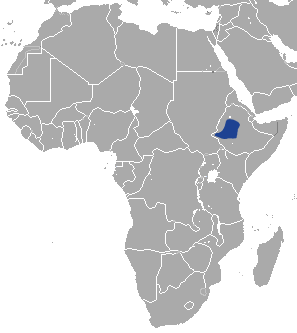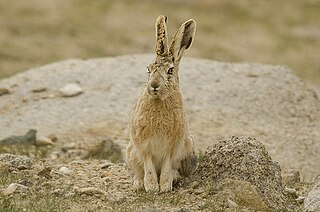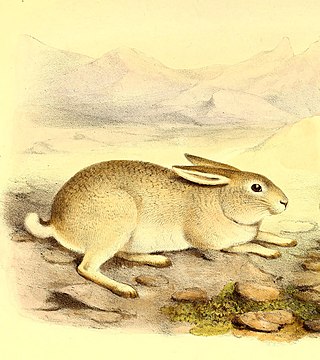
Hares and jackrabbits are mammals belonging to the genus Lepus. They are herbivores, and live solitarily or in pairs. They nest in slight depressions called forms, and their young are able to fend for themselves shortly after birth. The genus includes the largest lagomorphs. Most are fast runners with long, powerful hind legs, and large ears to dissipate body heat. Hare species are native to Africa, Eurasia and North America. A hare less than one year old is called a "leveret". A group of hares is called a "husk", a "down" or a "drove".

Leporidae is the family of rabbits and hares, containing over 60 species of extant mammals in all. The Latin word Leporidae means "those that resemble lepus" (hare). Together with the pikas, the Leporidae constitute the mammalian order Lagomorpha. Leporidae differ from pikas in that they have short, furry tails and elongated ears and hind legs.

The Cape hare, also called the brown hare and the desert hare, is a hare native to Africa and Arabia extending into India.

The Amur hedgehog, also called the Manchurian hedgehog, is a hedgehog similar to the European hedgehog in appearance and behaviour, although it is more lightly coloured. It is native to Amur Oblast and Primorye in Russia, Manchuria in China, and the Korean Peninsula. Like other hedgehogs, it uses scent and hearing while looking for prey, and the name "hedgehog" refers to the pig-like grunts it makes as it forages.

The Japanese hare is a species of hare endemic to Japan. In Japanese, it is called the Nousagi, meaning "field rabbit".

The Tehuantepec jackrabbit is a jackrabbit endemic to Mexico.

The Korean hare is a species of hare native to the Korean Peninsula and adjoining parts of northeastern China. The Korean hare inhabits diverse habitats within its range, from remote mountain forests to cultivated land. Fur colour varies slightly among individuals, but is generally some shade of liver brown.

The Yunnan hare is a medium-sized species of mammal in the family Leporidae. It has soft, flat, and long dorsal pelage which is grayish brown or dark gray in color, and whitish ventral pelage. It was considered endemic to China, but its presence was recorded in northern Myanmar in 2000. It is a herbivore, and forages on shrubs and forbs. It is rated as a species of least concern on the International Union for Conservation of Nature Red List of Endangered Species. The Red List of China's Vertebrates has listed the Yunnan hare as near threatened, almost meeting the criteria to be listed as vulnerable.

The Ethiopian hare is a species of mammal in the family Leporidae. It was first described in 1903, by the British mammalogist Oldfield Thomas. The dorsal pelage is brownish buff, and is finely grizzled with black. The ventral pelage is fluffy and white in colour. Endemic to Ethiopia, it is found in the Afromontane Biozone of Ethiopia, and in the borders of the Sudanian Savanna Biozone. It is rated as a least concern species by the International Union for Conservation of Nature.

The woolly hare is a species of mammal in the family Leporidae. It is found in western and central China, northern India, and Nepal, where its typical habitat is montane grassland. It has a wide range and is present in some protected areas but is a generally uncommon species; the International Union for Conservation of Nature has assessed its conservation status as being of "least concern".

The Burmese hare is a species of mammal in the family Leporidae. It is found in Cambodia, Laos, Myanmar, Thailand, and Vietnam.

The Chinese hare is a species of mammal in the family Leporidae. It is found in China, Taiwan and Vietnam.

The Ethiopian highland hare or Starck's hare is a medium-sized species of mammal in the rabbit and hare family, Leporidae. Its dorsal pelage is grizzled, buff white and spotted and streaked with black, while its belly fur is pure white and fluffy. It is endemic to the Ethiopian Highlands, ranging over the Afroalpine regions of the Shoa, Bale, and Arsi Provinces of Ethiopia. A herbivore, it mostly feeds on moorland grasses. The IUCN rates it as a species of least concern.

The Yarkand hare is a species of mammal in the family Leporidae. It has soft, straight, sandy brown dorsal pelage which has grayish-black stripes, and completely white ventral pelage. Endemic to China, the Yarkand hare is restricted to the Tarim Basin in Southern Xinjiang, China. It is mainly nocturnal, and forages on grass and crops. The female produces two or three litters annually, each consisting of two to five young. It is rated as near threatened on the International Union for Conservation of Nature Red List of Endangered Species and by the Red List of China's Vertebrates. However, Chinese geneticists have stated the species is "endangered" due to limited habitat and its fragmentation, and over-hunting and poaching.

Royle's pika, also called the Himalayan mouse hare or hui shutu, is a species of pika. It is found in Bhutan, China, India, Nepal, and Pakistan.

Thomas's pika, also known as the Thomas-pika, is a species of small mammal in the pika family, Ochotonidae. The fur on its upper body is reddish brown in summer, and mouse grey in winter. It is a generalist herbivore threatened by habitat loss, being found on isolated peaks of the eastern Qilian Mountains in Qinghai, Gansu, and northwestern Sichuan, in China. The International Union for Conservation of Nature Red List of Endangered Species assessed the animal as insufficiently known in 1994, as near threatened in 1996, and as a species of least concern in 2008.

The Natal red rock hare or greater red rock hare is a species of mammal in the family Leporidae. It has a slightly grizzled, grayish brown head and reddish brown upperparts. The dense fur is thick and rougher than other rock hares. It is endemic to Africa, and found in southeastern provinces of South Africa, eastern Lesotho, Eswatini, and southern Mozambique. It is a herbivore, primarily feeding on grass. It breeds throughout the year, and one or two pups are usually born in the summer. It is rated as a species of least concern on the IUCN Red List of Endangered Species.

The tolai hare is a species of hare native to Central Asia, Mongolia, and Northern and Central China. It inhabits semi-desert, steppes, rocky habitats, and forest meadows. It is relatively common, even in areas with heavy human disturbance, due to its fast reproductive rate. It is mainly active at dusk and at night but is occasionally active during the day.

The desert hare is a species of hare found in Central Asia, Northwest China, and the western Indian subcontinent. Little is known about this species except that it inhabits grassland and scrub areas of desert and semi-desert. The International Union for Conservation of Nature has assessed its conservation status as being of "least concern."





















